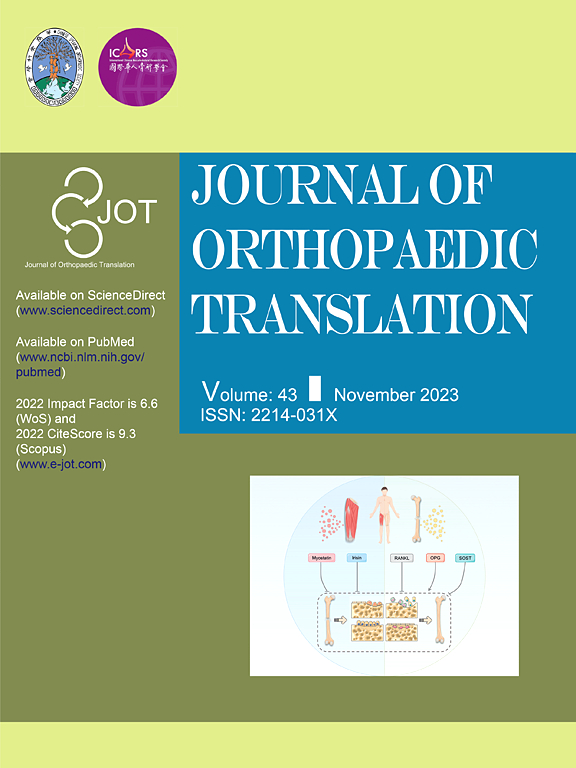The role of Piezo1 in bone marrow stem cells in response to elevated intraosseous pressure on regulating osteogenesis and angiogenesis of steroid-induced osteonecrosis of the femoral head
IF 5.9
1区 医学
Q1 ORTHOPEDICS
引用次数: 0
Abstract
Objectives
Steroid-induced osteonecrosis of the femoral head (SONFH) remains a significant global health issue, with an unclear pathogenesis. Elevated intraosseous pressure is considered a key initiating factor in SONFH development. Impaired osteogenesis and angiogenesis are believed to be critical in SONFH progression. Piezo1, a mechanosensitive cation channel, may sense changes in intraosseous pressure. In this study, we set out to explore the role of Piezo1 in SONFH and how to target Piezo1 to treat SONFH.
Methods
Femoral head tissue specimens were collected from patients with ONFH and femoral neck fracture. Histological staining, Western blotting, and RT-PCR analysis were conducted to investigate the relationship between elevated intraosseous pressure and SONFH in rat models. Immunofluorescence staining of femoral head tissues was performed to study the spatiotemporal relationship between elevated intraosseous pressure and angiogenesis, osteogenesis, and development of SONFH.
Results
In the early stages of SONFH, elevated intraosseous pressure increased angiogenesis and osteogenesis. However, as the pressure continued to rise, both processes were inhibited. Furthermore, Elevated intraosseous pressure activated the Piezo1 signaling pathway in bone marrow stem cells. Piezo1 activation led to increased intracellular calcium influx, thus enhancing osteogenesis and angiogenesis through CAM-NFAT1 signaling pathway.
Conclusion
In the early stages of SONFH, Piezo1 in BMSCs senses increased intraosseous pressure, promoting angiogenesis and osteogenesis. Targeting Piezo1 to promote the osteogenic and angiogenic potential of stem cells, which could curb further increases in pressure, contribute to early treatment of SONFH.
The translational potential of this article
Currently, many mechanisms of the impact of elevated intraosseous pressure on osteonecrosis of the femoral head are still in the basic theoretical research stage, and we hope to translate them into clinical applications as soon as possible. We discovered that targeting Piezo1 curb further increases in intraosseous pressure, alleviating the damaging effects of glucocorticoids on stem cells and blood vessels, which exerting great significance in treatment of early stage SONFH.

骨髓干细胞中Piezo1在骨内压力升高对激素性股骨头坏死成骨和血管生成的调节中的作用
目的:类固醇性股骨头坏死(SONFH)是一个重要的全球性健康问题,其发病机制尚不清楚。骨内压力升高被认为是SONFH发展的关键启动因素。骨生成和血管生成受损被认为是SONFH进展的关键。Piezo1是一种机械敏感的阳离子通道,可以感知骨内压力的变化。在本研究中,我们着手探索Piezo1在SONFH中的作用以及如何靶向Piezo1治疗SONFH。方法采集ONFH合并股骨颈骨折患者的股骨头组织标本。采用组织学染色、Western blotting、RT-PCR等方法研究骨内压力升高与模型大鼠SONFH的关系。对股骨头组织进行免疫荧光染色,研究骨内压力升高与血管生成、成骨和SONFH发展的时空关系。结果在SONFH早期,骨内压力升高可促进血管生成和成骨。然而,随着压力的持续升高,这两个过程都受到抑制。此外,骨内压力升高激活了骨髓干细胞中的Piezo1信号通路。Piezo1激活导致细胞内钙内流增加,从而通过CAM-NFAT1信号通路促进骨生成和血管生成。结论在SONFH早期,骨髓间充质干细胞中的Piezo1感受骨内压力增加,促进血管生成和成骨。以Piezo1为靶点,促进干细胞的成骨和血管生成潜能,从而抑制压力的进一步增加,有助于SONFH的早期治疗。目前,骨内压力升高对股骨头骨坏死影响的许多机制尚处于基础理论研究阶段,我们希望能尽快转化为临床应用。我们发现,靶向Piezo1抑制骨内压力的进一步升高,减轻糖皮质激素对干细胞和血管的损伤作用,这对早期SONFH的治疗具有重要意义。
本文章由计算机程序翻译,如有差异,请以英文原文为准。
求助全文
约1分钟内获得全文
求助全文
来源期刊

Journal of Orthopaedic Translation
Medicine-Orthopedics and Sports Medicine
CiteScore
11.80
自引率
13.60%
发文量
91
审稿时长
29 days
期刊介绍:
The Journal of Orthopaedic Translation (JOT) is the official peer-reviewed, open access journal of the Chinese Speaking Orthopaedic Society (CSOS) and the International Chinese Musculoskeletal Research Society (ICMRS). It is published quarterly, in January, April, July and October, by Elsevier.
 求助内容:
求助内容: 应助结果提醒方式:
应助结果提醒方式:


